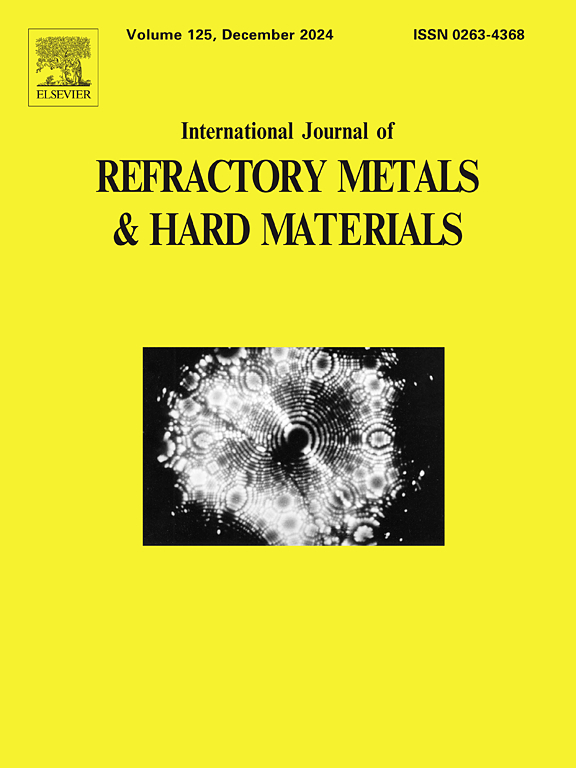Functional-gradient WC-TiC cemented carbides with alternative binders (Ni and Fe)
IF 4.2
2区 材料科学
Q2 MATERIALS SCIENCE, MULTIDISCIPLINARY
International Journal of Refractory Metals & Hard Materials
Pub Date : 2025-04-30
DOI:10.1016/j.ijrmhm.2025.107214
引用次数: 0
Abstract
In this work we investigate the development of functionally graded cemented carbides, featuring macro gradients on the millimeter scale, where Fe, or Ni is the binder phase. Two composites, WC-Ni and WC-Fe with 20 % binder by volume were produced by addition of TiC on the surface of the samples before sintering at 1475 °C for 1 h. The sintered samples were analyzed using electron microscopy and microanalysis.
For the Ni-binder sample, the results show a clear WC grain size gradient, with the smallest average grain size close to the TiC layer. This sample also exhibits compositional gradients, where Ni increases while Ti and C decrease from the added TiC layer and outward. The same effect of TiC addition on WC grain growth is observed in the Fe-binder sample, however, the effect is much smaller.
The addition of Ti is known to influence the morphology of WC grains in Co-binder systems, and this effect is observed here in both Ni- and Fe-binder samples. WC growth ledges areobserved on the WC facets near the applied TiC layer where Ti levels in the binder are high. This suggests that the WC grain growth inhibition mechanism imposed by Ti is similar in these alternative binders as what has previously been reported for conventional Co-binders.
可选粘结剂(Ni和Fe) WC-TiC功能梯度硬质合金
在这项工作中,我们研究了功能梯度硬质合金的发展,具有毫米级的宏观梯度,其中Fe或Ni是粘结相。在1475℃烧结1 h前,在样品表面添加TiC,制备了WC-Ni和WC-Fe两种粘结剂体积比为20%的复合材料。对于ni -粘合剂样品,WC晶粒尺寸梯度明显,最小平均晶粒尺寸接近TiC层。该样品也表现出组分梯度,从添加的TiC层向外,Ni增加,Ti和C减少。在铁结合剂样品中,添加TiC对WC晶粒生长有相同的影响,但影响要小得多。已知Ti的加入会影响共结合剂体系中WC晶粒的形貌,并且在Ni和fe结合剂样品中都观察到了这种影响。在粘结剂中钛含量高的TiC层附近的WC切面上观察到WC生长边缘。这表明,钛在这些替代粘合剂中施加的WC晶粒生长抑制机制与之前报道的传统共粘合剂相似。
本文章由计算机程序翻译,如有差异,请以英文原文为准。
求助全文
约1分钟内获得全文
求助全文
来源期刊
CiteScore
7.00
自引率
13.90%
发文量
236
审稿时长
35 days
期刊介绍:
The International Journal of Refractory Metals and Hard Materials (IJRMHM) publishes original research articles concerned with all aspects of refractory metals and hard materials. Refractory metals are defined as metals with melting points higher than 1800 °C. These are tungsten, molybdenum, chromium, tantalum, niobium, hafnium, and rhenium, as well as many compounds and alloys based thereupon. Hard materials that are included in the scope of this journal are defined as materials with hardness values higher than 1000 kg/mm2, primarily intended for applications as manufacturing tools or wear resistant components in mechanical systems. Thus they encompass carbides, nitrides and borides of metals, and related compounds. A special focus of this journal is put on the family of hardmetals, which is also known as cemented tungsten carbide, and cermets which are based on titanium carbide and carbonitrides with or without a metal binder. Ceramics and superhard materials including diamond and cubic boron nitride may also be accepted provided the subject material is presented as hard materials as defined above.

 求助内容:
求助内容: 应助结果提醒方式:
应助结果提醒方式:


